+ Open data
Open data
- Basic information
Basic information
| Entry | Database: PDB / ID: 6vfq | ||||||||||||
|---|---|---|---|---|---|---|---|---|---|---|---|---|---|
| Title | Crystal structure of monomeric human protocadherin 10 EC1-EC4 | ||||||||||||
 Components Components | Protocadherin-10 | ||||||||||||
 Keywords Keywords | CELL ADHESION / cadherin extracellular region / non-clustered delta2 family protocadherin / homophilic adhesion/recognition calcium-dependent adhesion molecule | ||||||||||||
| Function / homology |  Function and homology information Function and homology informationhomophilic cell-cell adhesion / nervous system development / postsynaptic membrane / cell adhesion / calcium ion binding / glutamatergic synapse / plasma membrane Similarity search - Function | ||||||||||||
| Biological species |  Homo sapiens (human) Homo sapiens (human) | ||||||||||||
| Method |  X-RAY DIFFRACTION / X-RAY DIFFRACTION /  SYNCHROTRON / SYNCHROTRON /  MOLECULAR REPLACEMENT / Resolution: 2.3 Å MOLECULAR REPLACEMENT / Resolution: 2.3 Å | ||||||||||||
 Authors Authors | Harrison, O.J. / Brasch, J. / Shapiro, L. | ||||||||||||
| Funding support |  United States, 3items United States, 3items
| ||||||||||||
 Citation Citation |  Journal: Cell Rep / Year: 2020 Journal: Cell Rep / Year: 2020Title: Family-wide Structural and Biophysical Analysis of Binding Interactions among Non-clustered δ-Protocadherins. Authors: Oliver J Harrison / Julia Brasch / Phinikoula S Katsamba / Goran Ahlsen / Alex J Noble / Hanbin Dan / Rosemary V Sampogna / Clinton S Potter / Bridget Carragher / Barry Honig / Lawrence Shapiro /  Abstract: Non-clustered δ1- and δ2-protocadherins, close relatives of clustered protocadherins, function in cell adhesion and motility and play essential roles in neural patterning. To understand the ...Non-clustered δ1- and δ2-protocadherins, close relatives of clustered protocadherins, function in cell adhesion and motility and play essential roles in neural patterning. To understand the molecular interactions underlying these functions, we used solution biophysics to characterize binding of δ1- and δ2-protocadherins, determined crystal structures of ectodomain complexes from each family, and assessed ectodomain assembly in reconstituted intermembrane junctions by cryoelectron tomography (cryo-ET). Homophilic trans (cell-cell) interactions were preferred for all δ-protocadherins, with additional weaker heterophilic interactions observed exclusively within each subfamily. As expected, δ1- and δ2-protocadherin trans dimers formed through antiparallel EC1-EC4 interfaces, like clustered protocadherins. However, no ectodomain-mediated cis (same-cell) interactions were detectable in solution; consistent with this, cryo-ET of reconstituted junctions revealed dense assemblies lacking the characteristic order observed for clustered protocadherins. Our results define non-clustered protocadherin binding properties and their structural basis, providing a foundation for interpreting their functional roles in neural patterning. | ||||||||||||
| History |
|
- Structure visualization
Structure visualization
| Structure viewer | Molecule:  Molmil Molmil Jmol/JSmol Jmol/JSmol |
|---|
- Downloads & links
Downloads & links
- Download
Download
| PDBx/mmCIF format |  6vfq.cif.gz 6vfq.cif.gz | 212.4 KB | Display |  PDBx/mmCIF format PDBx/mmCIF format |
|---|---|---|---|---|
| PDB format |  pdb6vfq.ent.gz pdb6vfq.ent.gz | 137.4 KB | Display |  PDB format PDB format |
| PDBx/mmJSON format |  6vfq.json.gz 6vfq.json.gz | Tree view |  PDBx/mmJSON format PDBx/mmJSON format | |
| Others |  Other downloads Other downloads |
-Validation report
| Summary document |  6vfq_validation.pdf.gz 6vfq_validation.pdf.gz | 360.5 KB | Display |  wwPDB validaton report wwPDB validaton report |
|---|---|---|---|---|
| Full document |  6vfq_full_validation.pdf.gz 6vfq_full_validation.pdf.gz | 360.5 KB | Display | |
| Data in XML |  6vfq_validation.xml.gz 6vfq_validation.xml.gz | 1.8 KB | Display | |
| Data in CIF |  6vfq_validation.cif.gz 6vfq_validation.cif.gz | 6.9 KB | Display | |
| Arichive directory |  https://data.pdbj.org/pub/pdb/validation_reports/vf/6vfq https://data.pdbj.org/pub/pdb/validation_reports/vf/6vfq ftp://data.pdbj.org/pub/pdb/validation_reports/vf/6vfq ftp://data.pdbj.org/pub/pdb/validation_reports/vf/6vfq | HTTPS FTP |
-Related structure data
| Related structure data |  6vfpC  6vfrC 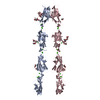 6vftC  6vfuC  6vfvC  6vfwC  6vg1C  6vg4C  5dzvS S: Starting model for refinement C: citing same article ( |
|---|---|
| Similar structure data |
- Links
Links
- Assembly
Assembly
| Deposited unit | 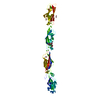
| ||||||||||||
|---|---|---|---|---|---|---|---|---|---|---|---|---|---|
| 1 |
| ||||||||||||
| Unit cell |
|
- Components
Components
-Protein , 1 types, 1 molecules A
| #1: Protein | Mass: 48309.922 Da / Num. of mol.: 1 Source method: isolated from a genetically manipulated source Source: (gene. exp.)  Homo sapiens (human) / Gene: PCDH10, KIAA1400 / Cell line (production host): HEK293 / Production host: Homo sapiens (human) / Gene: PCDH10, KIAA1400 / Cell line (production host): HEK293 / Production host:  Homo sapiens (human) / References: UniProt: Q9P2E7 Homo sapiens (human) / References: UniProt: Q9P2E7 |
|---|
-Sugars , 2 types, 3 molecules 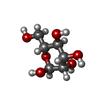
| #2: Polysaccharide | 2-acetamido-2-deoxy-beta-D-glucopyranose-(1-4)-[alpha-L-fucopyranose-(1-6)]2-acetamido-2-deoxy-beta- ...2-acetamido-2-deoxy-beta-D-glucopyranose-(1-4)-[alpha-L-fucopyranose-(1-6)]2-acetamido-2-deoxy-beta-D-glucopyranose Source method: isolated from a genetically manipulated source |
|---|---|
| #4: Sugar |
-Non-polymers , 4 types, 158 molecules 






| #3: Chemical | ChemComp-CA / #5: Chemical | ChemComp-ACT / | #6: Chemical | ChemComp-EDO / #7: Water | ChemComp-HOH / | |
|---|
-Details
| Has ligand of interest | N |
|---|---|
| Has protein modification | Y |
-Experimental details
-Experiment
| Experiment | Method:  X-RAY DIFFRACTION / Number of used crystals: 1 X-RAY DIFFRACTION / Number of used crystals: 1 |
|---|
- Sample preparation
Sample preparation
| Crystal | Density Matthews: 2.67 Å3/Da / Density % sol: 54 % |
|---|---|
| Crystal grow | Temperature: 296 K / Method: vapor diffusion, hanging drop / pH: 4.6 Details: 14% PEG 400 (v/v), 0.1M sodium acetate pH 4.6, 0.1M CaCl2, with 30% ethylene glycol (v/v) added as cryoprotectant |
-Data collection
| Diffraction | Mean temperature: 100 K / Serial crystal experiment: N |
|---|---|
| Diffraction source | Source:  SYNCHROTRON / Site: SYNCHROTRON / Site:  APS APS  / Beamline: 24-ID-C / Wavelength: 0.9792 Å / Beamline: 24-ID-C / Wavelength: 0.9792 Å |
| Detector | Type: DECTRIS PILATUS 6M-F / Detector: PIXEL / Date: Aug 23, 2016 |
| Radiation | Protocol: SINGLE WAVELENGTH / Monochromatic (M) / Laue (L): M / Scattering type: x-ray |
| Radiation wavelength | Wavelength: 0.9792 Å / Relative weight: 1 |
| Reflection | Resolution: 2.3→40 Å / Num. obs: 23366 / % possible obs: 99.7 % / Redundancy: 6.1 % / Biso Wilson estimate: 42.8528006313 Å2 / CC1/2: 1 / Rmerge(I) obs: 0.1 / Rpim(I) all: 0.044 / Rrim(I) all: 0.11 / Net I/σ(I): 11 |
| Reflection shell | Resolution: 2.3→2.38 Å / Redundancy: 4.7 % / Rmerge(I) obs: 0.89 / Mean I/σ(I) obs: 1.6 / Num. unique obs: 2283 / CC1/2: 0.83 / Rpim(I) all: 0.44 / Rrim(I) all: 1 / % possible all: 98.8 |
- Processing
Processing
| Software |
| |||||||||||||||||||||||||||||||||||||||||||||||||||||||||||||||
|---|---|---|---|---|---|---|---|---|---|---|---|---|---|---|---|---|---|---|---|---|---|---|---|---|---|---|---|---|---|---|---|---|---|---|---|---|---|---|---|---|---|---|---|---|---|---|---|---|---|---|---|---|---|---|---|---|---|---|---|---|---|---|---|---|
| Refinement | Method to determine structure:  MOLECULAR REPLACEMENT MOLECULAR REPLACEMENTStarting model: 5DZV Resolution: 2.3→19.93 Å / SU ML: 0.2916 / Cross valid method: FREE R-VALUE / σ(F): 1.34 / Phase error: 26.13
| |||||||||||||||||||||||||||||||||||||||||||||||||||||||||||||||
| Solvent computation | Shrinkage radii: 0.8 Å / VDW probe radii: 1.1 Å | |||||||||||||||||||||||||||||||||||||||||||||||||||||||||||||||
| Displacement parameters | Biso mean: 64.07 Å2 | |||||||||||||||||||||||||||||||||||||||||||||||||||||||||||||||
| Refinement step | Cycle: LAST / Resolution: 2.3→19.93 Å
| |||||||||||||||||||||||||||||||||||||||||||||||||||||||||||||||
| Refine LS restraints |
| |||||||||||||||||||||||||||||||||||||||||||||||||||||||||||||||
| LS refinement shell |
|
 Movie
Movie Controller
Controller











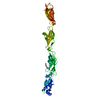


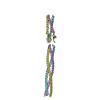
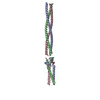

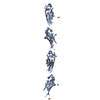

 PDBj
PDBj







